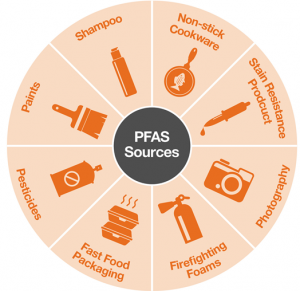When you buy bottled water, you are buying it for its purity compared to water from the tap. But you may be making a mistake. At least that is the case with bottled water that is on the shelves of many stores in the United States.
 Recently, the Environmental Working Group, a non profit based in Washington, DC released a report naming 610 places in 43 states that are contaminated with PFAS. PFAS is the abbreviation for man-made compounds, perfluoroalkyl and polyfluoroalkyl, substances which are also known as the “forever chemicals.” These compounds take thousands of years to break down and are found in soil, water and air.
Recently, the Environmental Working Group, a non profit based in Washington, DC released a report naming 610 places in 43 states that are contaminated with PFAS. PFAS is the abbreviation for man-made compounds, perfluoroalkyl and polyfluoroalkyl, substances which are also known as the “forever chemicals.” These compounds take thousands of years to break down and are found in soil, water and air.
As “forever chemicals,” they build up in our bodies through consumption of water and food. The have been linked to liver problems, cancers and low birth weight, as well as impacting the immune system, thyroid and metabolism. Between 98 and 99 percent of Americans have these substances in their bodies.
Created to repel grease, water and stains, PFAS have been used in carpeting, cookware, pizza boxes, outdoor clothing even dental floss.  Exposure to PFAS can occur because food is grown in contaminated soil and/or watered with contaminated water. Food packaging (like microwave popcorn bags and fast food wrappers) contain PFAS and food may be processed with equipment containing PFAS. Non-stick pans and kitchen utensils Teflon, Scotchgard, Gore-Tex, PolarTec and StainMaster are products that are put in clothing. Personal care products that have “Fluoro” and/or “PTFE” in their list of ingredients contain PFAS. Even Oral-B Glide dental floss contains PFAs.
Exposure to PFAS can occur because food is grown in contaminated soil and/or watered with contaminated water. Food packaging (like microwave popcorn bags and fast food wrappers) contain PFAS and food may be processed with equipment containing PFAS. Non-stick pans and kitchen utensils Teflon, Scotchgard, Gore-Tex, PolarTec and StainMaster are products that are put in clothing. Personal care products that have “Fluoro” and/or “PTFE” in their list of ingredients contain PFAS. Even Oral-B Glide dental floss contains PFAs.
Unfortunately, the Environmental Protection Agency (EPA) has only set up a “health advisory level”of 70 nanograms per liter (ng/L) which is not a legally binding limit on the amount of PFAS that can be present in drinking water. States are trying to fill in the gap. In fact, New Hampshire just passed a law to limit the amount of PFAS in their drinking water. An interactive map of contaminated locations in the US is available on the EWG website.






Thanks so much for this information.
You are welcome. Best, Kathleen
Wish this article were more in depth